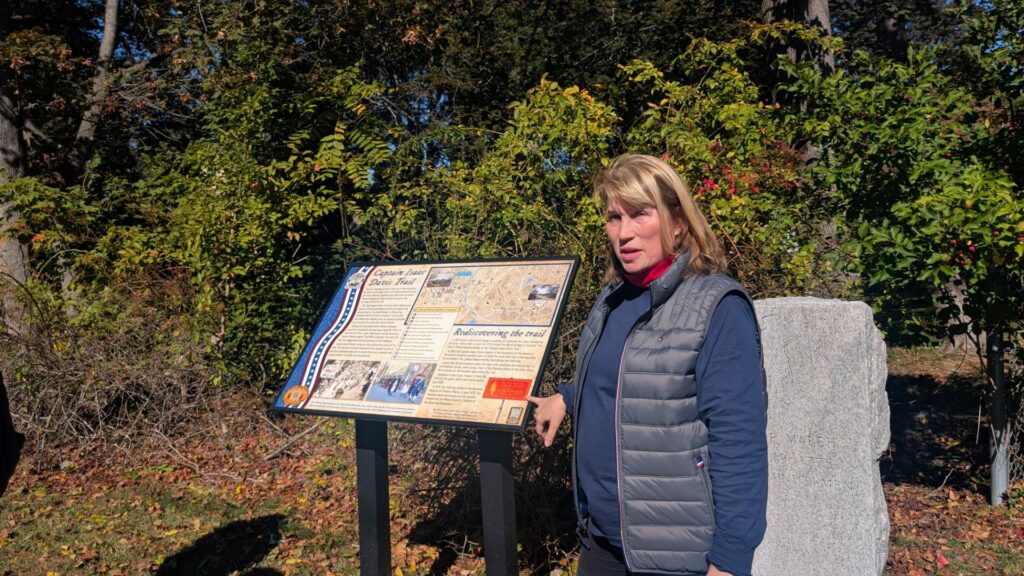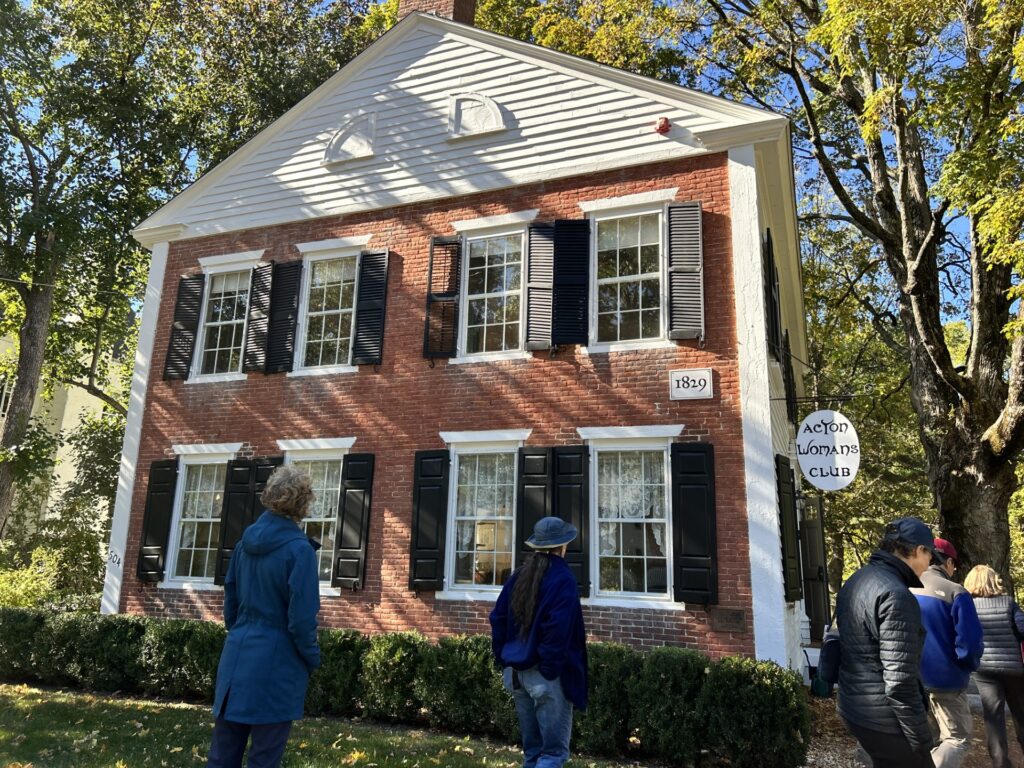Why did Acton become its own town in 1735? The answer is relatable for many current Acton residents: the commute was too long.
Acton’s history was explained by Amy Cole, on Thursday, October 9, on a walking tour focused on Acton Center and sponsored by the Acton 250 Committee. Cole, an Acton resident, is a professional tour guide, has given numerous talks on Acton, and also works at the Concord Visitor Center. Future Acton 250 activities can be found at Acton 250th Events.

The center of activity of any early colonial town was the meeting house, which doubled as a Congregationalist church. Indeed, every town in early? Massachusetts was required to have a meeting house and a minister.
Prior to Acton becoming its own town, it was a Concord extension (through a series of land grants mostly in the 1650s) for pastures, crops, and timber. Consequently, early residents of what is now Acton had to travel far to get to the meeting house in Concord. Unsurprisingly, after eighty plus years of trudging to Concord, they petitioned for their own town, with a closer meeting house and their own minister.
The meeting house was intentionally situated in the geographic center of the new town, so it was equidistant for everybody. Acton Center is literally the center — by design, not by coincidence.
The first meeting house-cum-church was located at the corner of Nagog Hill Road and Main Street. The grassy “Meeting House Hill,” in the northwest corner of the intersection, is currently maintained by Acton Garden Club, Cole said. A tavern house was strategically located across Main Street. However, Main Street, as we know it, didn’t exist in the 1700s. In fact, Minuteman Road was a main road and cut behind what is now the Acton Memorial Library. Meeting House Hill is currently maintained by the Acton Garden Club.
This older road is part of the 6-mile Isaac Davis Trail, which was re-established by Acton Boy Scouts in 1957 and is now marked with a dozen granite pillars. The granite pillars were installed in 1975; prior to that, there were wooden markers.

Isaac Davis, the first officer to die in the Revolutionary war, is not just an Acton hero, but an American hero as well. Daniel Chester French’s The Minute Man statue at the North Bridge (unveiled in 1875) represents the citizen farmer. Although it is not a statue of Davis per se, the artist did look at photographs of Davis’ descendants to model a likeness.

There is some debate about why the Acton Minutemen were placed in the front line at the North Bridge. The prevailing view is that Davis’ men were better trained and equipped. Davis was a gunsmith and recognized the typical hunting musket was not suitable for battle. Instead of the cumbersome powder horn, his men used cartridges (bundling pre-measured powder and balls together), which made the gun faster to reload. Moreover, he trained his men twice a week and had a shooting range in the back of his house. Finally, and most relevant for the North Bridge standoff, his company’s guns were fitted for bayonets, unlike the other towns’ weapons.
Many eyewitnesses did confirm that, when asked by Major Butrick if he was afraid to take the lead, he said “No, I am not and I haven’t a man who is afraid to go.”
Cole described the history of Acton Center’s development, showing the group where different meeting houses, commercial buildings, and churches were located. Differing religious views percolated in Acton in the first half of the 1800s. This Second Great Awakening, a Protestant religious revival in the U.S. in the late 18th and early 19th century, swept across the Northeast and changed citizens’ views on abolition, temperance, and women’s rights.
During this time, the current home of the Acton Woman’s Club (AWC) was built, in 1829, originally as a chapel for the Evangelical Society. As that group became bigger, they moved to the site of the current Congregational Church (renamed in the 1960s) on Concord Road in the center.

The tour visited the AWC, where Carolyn Kilpatrick shared the history of the building and the club. Your correspondent relived his own personal history by walking through the upstairs hall where generations of anxious, awkward, elementary and junior high students have taken ballroom dance and social etiquette lessons.
Cole covered many topics, including Acton’s other heroes of the Revolutionary War, the Civil War, and residential and commercial development in the center. There is one last story to leave with the reader. In 1851, Acton celebrated the building of the Isaac Davis Monument by exhuming the bodies of the three fallen heroes of April 19, 1775 (Isaac Davis, James Hayward, and Abner Hosmer) from Woodlawn Cemetery for re-internment at the monument. Before that, however, the caskets were opened for public viewing, followed by a banquet for the guests and visiting dignitaries. It was reported that the bodies were remarkably well-preserved.
Jens Teagan grew up in Acton and his parents live in Minuteman Ridge. He has lived in multiple states and countries. However, wherever he is, he is sure to regale people about the importance of Acton in the country’s history.












